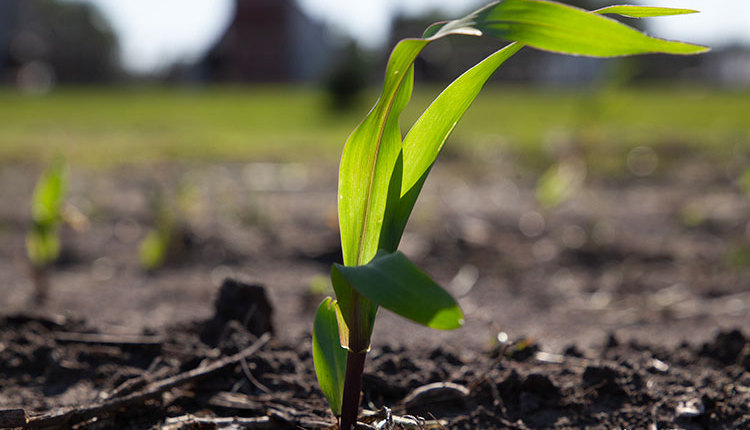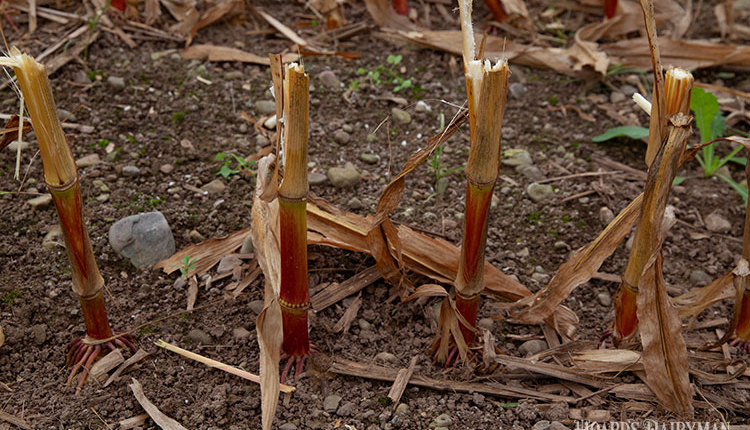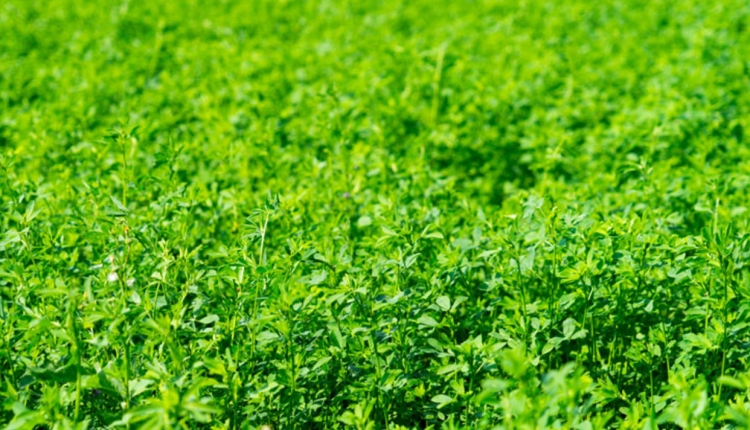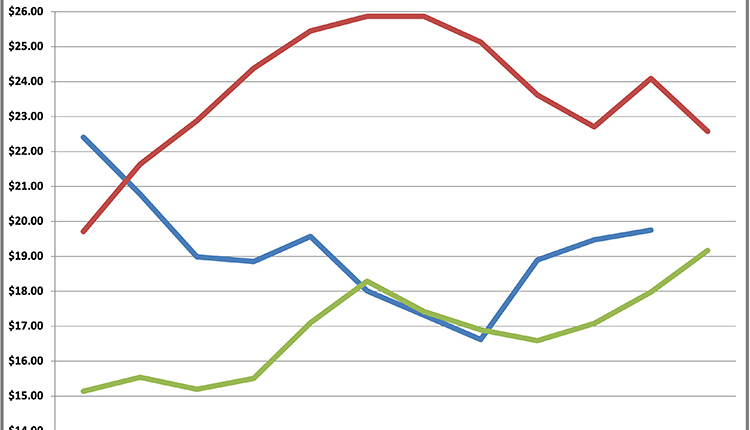Years of repeated tillage and equipment traffic have left many farm soils compacted. In some cases, this compaction can cause water to pond and also lead to shallow root depths which limit crop yields. To counteract this situation, some Indiana corn and soybean farmers have turned to gypsum to address the problem.
Gypsum is one of the oldest fertilizers used in agriculture. It is a common mineral and is an excellent source of soluble calcium and sulfur. However, except for certain specialty crops, gypsum has not been widely used in modern cropping systems because it is expensive to mine.
Since the 1990 revisions to the U.S. Clean Air Act, synthetic gypsum has become more readily available because it is a by-product of the process that cleans the air in coal-fired power plants by removing sulfur dioxide (SO2). "By 2020, there is expected to be 40 million tons of synthetic gypsum produced each year," says Ron Chamberlain who markets gypsum to agricultural producers through the commercially branded name Gypsoil.
The resulting synthetic gypsum, sometimes called FGD (flue gas desulfurization) gypsum, can be at least as pure as the mined product. It is safe to use and is regularly tested by natural resource agencies in the state where it is produced. And, at the moment, the Environmental Protection Agency (EPA) is considering regulations for use of coal combustion residuals, including gypsum. This synthetic gypsum also serves as the core material in drywall used to build houses, but more of the product is being produced than can be used in that market, especially considering the current housing market.
In what certainly can be tagged as an irony, the same Clean Air Act that has reduced sulfur admissions in the air has caused sulfur to become deficient in soils because it is no longer falling to the earth in rainwater. Synthetic gypsum from power plants can turn around and add the vital element back to the soil profile.
While the nutrients are an important part of gypsum, its main benefit is the fact it loosens soil particles to improve air and water movement throughout the soil profile. This action also improves the environment for soil organisms such as earthworms that help breakdown organic matter. In turn, that action releases vital nutrients into the soil, making nutrients more readily available to plants.
Down on the farm
Two Indiana farmers have been using the product for seven years on their corn and soybean operation. Jack Maloney who farms in Brownsburg and Jamestown, Ind., just west of Indianapolis, has seen major improvements to his soil. Water does not stand in his fields like it did before he began using gypsum.
"We can have 2 inches of rain and it won't pond," said Maloney who adds 1 ton of gypsum per acre to his fields every other year. "With gypsum, we have a higher permeability rate," said Maloney who uses no-till practices on his farm fields.
Commercial fertilizer use has gone down on the Maloney farm since gypsum started being applied seven years ago. "Our phosphorus and potassium costs are way down because our soil tests tell me not as much are required," Maloney commented.
Comparing results on his fields where gypsum has been applied versus conventional fields where no gypsum is applied, Maloney said he has calculated a $162-per-acre savings in input costs assuming typical fertilizer application rates for conventional fields at today's market prices. "We've increased yield and lowered costs dramatically," he said.
Both Maloney and a nearby neighbor, Mike Starkey, have been using similar practices on their farms. During that time, an independent study was taking place. The Eagle Creek Watershed Alliance, a local water quality study coalition, was looking at water quality for streams entering the Eagle Creek Reservoir which supplies water to nearby Indianapolis. They found the water draining from the School Branch, the same branch that collects water from some 5,500 acres of farm fields, farmed by Maloney and Starkey, was lower in agricultural nutrients and chemicals. Researchers are conducting further investigations, but they believe that the greater soil permeability from the repeated gypsum applications has caused better plant use of nutrients and reduced runoff.
While these results are exciting, gypsum is not a product that creates instant success. "Expectations need to be appropriate," says Chamberlain. "Don't expect a yield response or improved soil tests in the first year. It may take up to three years to see softer soils in a no-till environment," he notes. "In the second year, you'll begin to see a little more earthworm activity."
Application rates and costs
Typical application rates are 1 to 2 tons per acre, every one to two years. It is applied like lime but does not replace it since lime adjusts soil pH. A typical gypsum application costs $30 to $50 per acre. The mineral itself is relatively low-cost; it is the trucking cost that drives up the price.
While much of the initial work has been done on corn and soybean fields, gypsum can benefit alfalfa, too. Field trials are currently underway to document improved soil conditions with that crop.
Since the 1920s, large-scale poultry operations have dotted Maryland's Chesapeake Bay Eastern Shore. Today, over 750,000 tons of poultry litter and manure are produced each year in the area. Not only have nutrient levels built up in the soil during this time, but the nutrients are also finding their way into our waterways and the Bay.
Scientists from USDA's Agricultural Research Service and the University of Maryland-Eastern Shore have developed a way to trap "legacy phosphorus" from the region's poultry farms that leaches from soil to drainage ditches.
Researchers dug a trench along a drainage ditch at the site of a former chicken farm and lined the trench with synthetic gypsum. When the groundwater passed out of the field and through the gypsum-filled trench, the soluble calcium in the gypsum "captured" the soluble phosphorus in the water by combining with it to form calcium phosphate. Calcium phosphate is similar to rock phosphate which is the source of phosphates used to make fertilizer. During the project, researchers found that the gypsum trench could treat all the water draining from a field and reduce soluble phosphorus in subsurface drainage by about 50 percent.
"These gypsum ‘curtains' are good for 10 years," said Ray Bryant who worked on the project. "Then they can be dug up and the trapped phosphorus can be used again for fertilizer."
Click here to return to the Crops & Forages E-Sources
1012_824
Gypsum is one of the oldest fertilizers used in agriculture. It is a common mineral and is an excellent source of soluble calcium and sulfur. However, except for certain specialty crops, gypsum has not been widely used in modern cropping systems because it is expensive to mine.
Since the 1990 revisions to the U.S. Clean Air Act, synthetic gypsum has become more readily available because it is a by-product of the process that cleans the air in coal-fired power plants by removing sulfur dioxide (SO2). "By 2020, there is expected to be 40 million tons of synthetic gypsum produced each year," says Ron Chamberlain who markets gypsum to agricultural producers through the commercially branded name Gypsoil.
The resulting synthetic gypsum, sometimes called FGD (flue gas desulfurization) gypsum, can be at least as pure as the mined product. It is safe to use and is regularly tested by natural resource agencies in the state where it is produced. And, at the moment, the Environmental Protection Agency (EPA) is considering regulations for use of coal combustion residuals, including gypsum. This synthetic gypsum also serves as the core material in drywall used to build houses, but more of the product is being produced than can be used in that market, especially considering the current housing market.
In what certainly can be tagged as an irony, the same Clean Air Act that has reduced sulfur admissions in the air has caused sulfur to become deficient in soils because it is no longer falling to the earth in rainwater. Synthetic gypsum from power plants can turn around and add the vital element back to the soil profile.
While the nutrients are an important part of gypsum, its main benefit is the fact it loosens soil particles to improve air and water movement throughout the soil profile. This action also improves the environment for soil organisms such as earthworms that help breakdown organic matter. In turn, that action releases vital nutrients into the soil, making nutrients more readily available to plants.
Down on the farm
Two Indiana farmers have been using the product for seven years on their corn and soybean operation. Jack Maloney who farms in Brownsburg and Jamestown, Ind., just west of Indianapolis, has seen major improvements to his soil. Water does not stand in his fields like it did before he began using gypsum.
"We can have 2 inches of rain and it won't pond," said Maloney who adds 1 ton of gypsum per acre to his fields every other year. "With gypsum, we have a higher permeability rate," said Maloney who uses no-till practices on his farm fields.
Commercial fertilizer use has gone down on the Maloney farm since gypsum started being applied seven years ago. "Our phosphorus and potassium costs are way down because our soil tests tell me not as much are required," Maloney commented.
Comparing results on his fields where gypsum has been applied versus conventional fields where no gypsum is applied, Maloney said he has calculated a $162-per-acre savings in input costs assuming typical fertilizer application rates for conventional fields at today's market prices. "We've increased yield and lowered costs dramatically," he said.
Both Maloney and a nearby neighbor, Mike Starkey, have been using similar practices on their farms. During that time, an independent study was taking place. The Eagle Creek Watershed Alliance, a local water quality study coalition, was looking at water quality for streams entering the Eagle Creek Reservoir which supplies water to nearby Indianapolis. They found the water draining from the School Branch, the same branch that collects water from some 5,500 acres of farm fields, farmed by Maloney and Starkey, was lower in agricultural nutrients and chemicals. Researchers are conducting further investigations, but they believe that the greater soil permeability from the repeated gypsum applications has caused better plant use of nutrients and reduced runoff.
While these results are exciting, gypsum is not a product that creates instant success. "Expectations need to be appropriate," says Chamberlain. "Don't expect a yield response or improved soil tests in the first year. It may take up to three years to see softer soils in a no-till environment," he notes. "In the second year, you'll begin to see a little more earthworm activity."
Application rates and costs
Typical application rates are 1 to 2 tons per acre, every one to two years. It is applied like lime but does not replace it since lime adjusts soil pH. A typical gypsum application costs $30 to $50 per acre. The mineral itself is relatively low-cost; it is the trucking cost that drives up the price.
While much of the initial work has been done on corn and soybean fields, gypsum can benefit alfalfa, too. Field trials are currently underway to document improved soil conditions with that crop.
Gypsum collects phosphorus
Since the 1920s, large-scale poultry operations have dotted Maryland's Chesapeake Bay Eastern Shore. Today, over 750,000 tons of poultry litter and manure are produced each year in the area. Not only have nutrient levels built up in the soil during this time, but the nutrients are also finding their way into our waterways and the Bay.
Scientists from USDA's Agricultural Research Service and the University of Maryland-Eastern Shore have developed a way to trap "legacy phosphorus" from the region's poultry farms that leaches from soil to drainage ditches.
Researchers dug a trench along a drainage ditch at the site of a former chicken farm and lined the trench with synthetic gypsum. When the groundwater passed out of the field and through the gypsum-filled trench, the soluble calcium in the gypsum "captured" the soluble phosphorus in the water by combining with it to form calcium phosphate. Calcium phosphate is similar to rock phosphate which is the source of phosphates used to make fertilizer. During the project, researchers found that the gypsum trench could treat all the water draining from a field and reduce soluble phosphorus in subsurface drainage by about 50 percent.
"These gypsum ‘curtains' are good for 10 years," said Ray Bryant who worked on the project. "Then they can be dug up and the trapped phosphorus can be used again for fertilizer."
1012_824

















